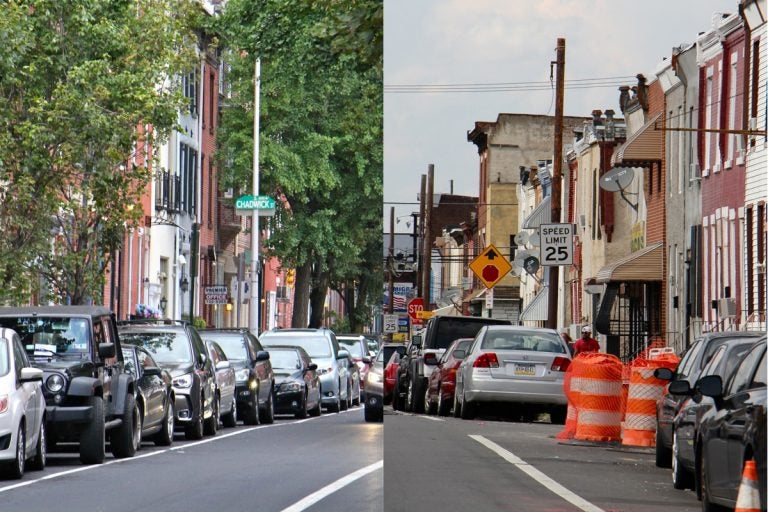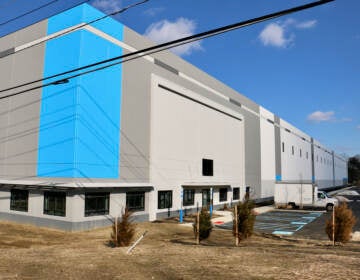Philly’s low-income neighborhoods have fewer trees and the city’s free tree program isn’t helping
A new analysis shows where the city has street trees, revealing a gap between well-off neighborhoods and those with higher rates of poverty.

Leafy Pine Street in Center City is contrasted with treeless North 5th Street in Hunting Park. (Emma Lee/WHYY)
This story originally appeared on PlanPhilly.
Places like the 2100 block of Spruce Street are about as wealthy and as leafy as they get in inner-city Philadelphia. The multi-million dollar brownstones here are shaded by a canopy of more than a dozen street trees, from narrow Ginkgos to mature Buttonwoods.
But head not too far south and the picture is very different.
On sunscorched row home blocks in Point Breeze, like the 1600 block of South 24th Street, there are sometimes no trees at all. Although Point Breeze is gentrifying, the poverty rate is 10 times higher than Rittenhouse and well over the citywide average.
That’s because Philadelphia’s streets are not equally green. Poor neighborhoods have fewer street trees than wealthier ones, making them more vulnerable to the effects of extreme heat and heavy rains. But although city officials are aware of the inequity, years of scarce resources and problems with the city’s method for planting new street trees means this disparity is perpetuating itself, not going away.
Philly has historically fared poorly as a whole when it comes to tree cover. Recent studies have found that just 20% of all city land is covered by trees, less than any other major Northeastern city.
Some areas, like those north of Chinatown or parts of South Philly, have an existing tree canopy of just 3%, despite an abundance of neighborhood parks. Forest ecologists define tree canopy as the layer of leaves, stems and branches that cover the ground when viewed from above.
The leafiest sections of Philadelphia — mainly blocks near Wissahickon or Pennypack parks — recorded canopy averages above 80%.
A PlanPhilly analysis shows that this gap closely correlates to neighborhood income, with the poorest half of city residents residing in census tracts that account for just one third of all city street trees.
Mapping the locations of 111,000 street trees tracked by the city makes this disparity even more apparent. In wealthier areas, like Fairmount, trees form a lush green grid. Just to the north in Brewerytown and Strawberry Mansion, where the poverty rate is three times higher, the tree cover runs patchy.
There are exceptions to the rule. Some well-to-do areas struggle with scant green and vice versa. Ken Steif, a lecturer at the University of Pennsylvania’s Department of City and Regional Planning, said that’s because there’s no singular reason that some neighborhoods wound up with more or less trees over Philadelphia’s centuries-long development.
“There are natural, historical reasons that some places have more trees than others,” he said. “The story of South Philly is that there were cultural reasons. Italian immigrants wanted to be able to look out onto their block and see what was happening on their block, and having trees prevented that.”
The city plants more trees in wealthier areas – and it’s a problem
But while the underlying causes for the city’s tree disparity –– cultural preferences, historical development patterns, municipal neglect –– may be debatable, the disparity today is not.
“We are definitely aware that there are more trees in higher income areas and less trees in lower-income areas,” said Erica Smith Fichman, who has managed TreePhilly, a city program that distributes free trees to city residents, since its creation in 2012.
Fichman said this is a problem because the disparity leaves those lower-income areas “more vulnerable areas to heat and other environmental problems.” That’s partially because shadier neighborhoods are also cooler neighborhoods, with temperatures that can be up to 22 degrees Fahrenheit colder than the hottest parts of the city.
Reducing that heat difference could prevent heat-related illnesses and even save lives. Three Philadelphians died from heat-related causes last year and a recent report projects that the city may see an average of 29 days-a-year with a heat index over 100 degrees by 2036. Already this summer, the city has recorded one heat-related death. The 70-year-old West Philadelphia man died Saturday.
Higher poverty rates also translate into higher rates of asthma and fewer resources to keep homes cool. Low-income residents, immigrants and communities of color have less access to air conditioned spaces or cooling centers. The same is true for their children, as most Philadelphia public schools are not air conditioned — out of 275 district buildings, only 65 have central AC.
Cities are naturally hotter because buildings and pavement trap warmth –– known as the urban heat island effect –– and street tree plantings are one of the few tools municipal administrators have to combat this phenomena. With climate change translating into hotter summers, experts say the city doesn’t need to just plant more trees, it needs to plant a lot more trees.
“It’s not just about planting trees, it’s also about the density,” said Steif. “The greater the density, the more aggregate effect.”
How many trees does a city of nearly 1.6 million need?
The city says it has a goal of increasing the percentage of trees in all neighborhoods to 30% by 2025 and partners with the non-profit Pennsylvania Horticultural Society to pay for trees, planting events and organize “tree tender” groups. The city’s Water Department also plant trees through its green stormwater infrastructure program, called Green City, Clean Waters.
But, while the city has planted thousands of new street trees, Fichman acknowledged these programs haven’t made as much progress in closing the gap between rich and poor neighborhoods as officials would like.
Currently, TreePhilly and related programs that give out free street trees won’t plant without a property owner’s permission. Smith said some residents perceive owning or maintaining trees as expensive or otherwise problematic.
“Concerns people have are that trees will lift your sidewalk; they’ll get into your pipes; they’ll drop their leaves, or people don’t want to clean up after the leaves,” she said. “One or two people have said to us that they’ll attract bears.”
But there’s also a lack of engagement with poorer communities, where residents often simply don’t know about the program. And the city’s application process is relatively slow: It can take anywhere from a few months to over a year to inspect and approve a spot, choose a proper tree, find the funds, make contracts with a vendor, and plant the tree. Smith said that the city does not currently prioritize giving street trees for residents applying from less leafy neighborhoods.
Without change, according to Fichman, these programs may never truly resolve the uneven distribution of street trees because people in higher income inevitably participate more often. She says the problem is so dire the city may be on the verge of radically overhauling the way the city plants street trees.
Currently, anyone can request a free tree from the city, but Fichman said the city could prioritize requests coming from less leafy neighborhoods. Or eliminate the need for a homeowners authorization. Cities like New York and Baltimore don’t plant trees upon request and don’t require residents’ permission.
“What do we want and what are other cities doing? Should it be by request and open to the entire city or should we be prioritizing where we are planting street trees?” Smith said. “These are the questions that we are excited to be asking.”
Ultimately, these are changes to a program that is fundamentally too small for a city of nearly 1.6 million residents. Fichman said a lack of funding limits the number of trees that are planted citywide each year to about 700 to 1,000 annually.
For perspective, that’s about the number of trees that just one neighborhood, Hunting Park, would need to reach its tree canopy goal of 30%. Currently, trees only cover 3% of the neighborhood, one that has some of the highest average temperatures in the city.
Esperanza, an Hispanic community organization serving Hunting Park, started planting trees there in 2012. The organization has given away about 800 yard and street trees. The group has also partnered with PHS, TreePhilly and the Office of Sustainability to implement a pilot program to reduce the heat in the neighborhood.
But David Ortiz, Esperanza’s vice president for Housing and Economic Development, says his organization would need more staff in order to see significant results.
“We do the education, we do the outreach,” Ortiz said. “[But] there’s not a whole lot of folks who actually go through the entire process or may even apply [to get a tree planted].”
Policy changes could close the green gap
Ezperanza hopes community outreach and education can promote the benefits of having trees and walk residents through the process of applying for a free street tree. But Ortiz said the only way of changing the trend of having less trees in poor neighborhoods is by devoting more resources.
Federal studies, examining the costs and benefits of urban forestry programs in five U.S. cities, show that the expense could pay for itself in the long run. A report published in the Journal of Forestry found that the annual costs for tree programs ranged from $15 to $65 per tree in 2005. But the annual benefits ranged from $30 to $90 per tree — including reduced energy use, less pavement maintenance, and better quality of life, air and water.
Steif says the negative impacts of Philadelphia’s tree shortage will only grow as climate change worsens –– but the city isn’t keeping up.
“To me, it’s less about whether there is a correlation [between the amount of trees and poor neighborhoods] and more about understanding that there are vulnerable populations affected by the urban heat island effect,” Steif said.
He believes the city would have to significantly scale up the pace of tree planting to effectively fight the phenomonom. “I haven’t seen evidence that the scale of tree planting in Philly would have a major impact on urban heat island.”
Meanwhile, a new report of the city’s tree canopy by the University of Vermont Spatial Analysis Lab is on the way in Philly and city officials are in the process of drafting a request for proposals for a consultant team to lead the urban forest strategic plan. The process which will involve working with different stakeholders and holding public meetings should start early next year.
But that new plan won’t be ready until 2021. And that will leave community advocates, like Ortiz, waiting years to get some shade.
“I think we plant about 50 trees a year,” he said. “It’s sort of a drop in a bucket.”
WHYY is your source for fact-based, in-depth journalism and information. As a nonprofit organization, we rely on financial support from readers like you. Please give today.








